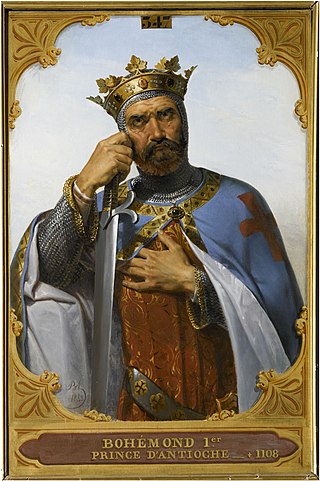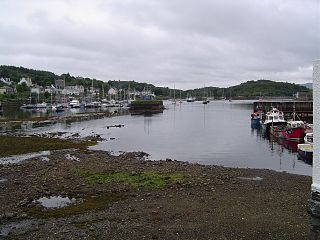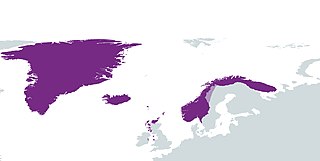Related Research Articles

Year 1093 (MXCIII) was a common year starting on Saturday of the Julian calendar.

Year 1103 (MCIII) was a common year starting on Thursday of the Julian calendar.

Harald Sigurdsson, also known as Harald III of Norway and given the epithet Hardrada in the sagas, was King of Norway from 1046 to 1066. Additionally, he unsuccessfully claimed both the Danish throne until 1064 and the English throne in 1066. Before becoming king, Harald had spent around fifteen years in exile as a mercenary and military commander in Kievan Rus' and as a chief of the Varangian Guard in the Byzantine Empire. In his chronicle, Adam of Bremen called him the "Thunderbolt of the North".

Magnus Olafsson, better known as Magnus the Good, was King of Norway from 1035 and King of Denmark from 1042 until his death in 1047.

The Orkneyinga saga is a narrative of the history of the Orkney and Shetland islands and their relationship with other local polities, particularly Norway and Scotland. The saga has "no parallel in the social and literary record of Scotland" and is "the only medieval chronicle to have Orkney as the central place of action". The main focus of the work is the line of jarls who ruled the Earldom of Orkney, which constituted the Norðreyjar or Northern Isles of Orkney and Shetland and there are frequent references to both archipelagoes throughout.

Olaf III or Olaf Haraldsson, known as Olaf the Peaceful, was King of Norway from 1067 until his death in 1093.
Magnus Haraldsson was King of Norway from 1066 to 1069, jointly with his brother Olaf Kyrre from 1067. He was not included in official Norwegian regnal lists until modern times, but has since been counted as Magnus II.
Haakon Magnusson, byname Toresfostre, was king of Norway from 1093 to 1095. Haakon was only partially recognized within Norway and his reign was thus of limited significance. He has generally not been counted in the numbered series of Norwegian kings.

Magnus III Olafsson, better known as Magnus Barefoot, was the King of Norway from 1093 until his death in 1103. His reign was marked by aggressive military campaigns and conquest, particularly in the Norse-dominated parts of the British Isles, where he extended his rule to the Kingdom of the Isles and Dublin.
Olaf or Olav is a Dutch, Polish, Scandinavian and German given name. It is presumably of Proto-Norse origin, reconstructed as *Anu-laibaz, from anu "ancestor, grand-father" and laibaz "heirloom, descendant". Old English forms are attested as Ǣlāf, Anlāf. The corresponding Old Novgorod dialect form is Uleb. A later English form of the name is Olave.
Sigurd Magnusson, also known as Sigurd the Crusader, was King of Norway from 1103 to 1130. His rule, together with his half-brother Øystein, has been regarded by historians as a golden age for the medieval Kingdom of Norway. He is otherwise famous for leading the Norwegian Crusade (1107–1110), earning the eponym "the Crusader", and was the first European king to personally participate in a crusade.

The Fairhair dynasty was a family of kings founded by Harald I of Norway which united and ruled Norway with few interruptions from the latter half of the 9th century. In the traditional view, this lasted until 1387, however, many modern scholars view this rule as lasting only three generations, ending with Harald Greycloak in the late 10th century. The moniker "Fairhair dynasty" is a retrospective construction: in their lifetime what little traces there are refer to them consistently as "Ynglings".

Muircheartach Ua Briain, son of Toirdelbach Ua Briain and great-grandson of Brian Boru, was King of Munster and later self-declared High King of Ireland.
Thorfinn Sigurdsson, also known as Thorfinn the Mighty, was an 11th-century Jarl of Orkney. He was the youngest of five sons of Jarl Sigurd Hlodvirsson and the only one resulting from Sigurd's marriage to a daughter of Malcolm II of Scotland. He ruled alone as jarl for about a third of the time that he held the title and jointly with one or more of his brothers or with his nephew Rögnvald Brusason for the remainder. Thorfinn married Ingibiorg Finnsdottir, daughter of Finn Arnesson, Jarl of Halland.
Magnús Óláfsson was a King of Mann and the Isles. He was a son of Óláfr Guðrøðarson, King of the Isles, and a member of the Crovan dynasty. Magnús' realm encompassed Mann and parts of the Hebrides. Some leading members of Magnús' family—such as his father—styled themselves "King of the Isles"; other members—such as Magnús and his brothers—styled themselves "King of Mann and the Isles". Although kings in their own right, leading members of the Crovan dynasty paid tribute to the Kings of Norway and generally recognised a nominal Norwegian overlordship of Mann and the Hebrides. Magnus was driven out by King Alexander III.
Olaf of Norway – Norwegian: Olav - may refer to:

East Loch Tarbert, Argyll is a small sea loch on the eastern side of the Kintyre peninsula in Scotland. It is a part of the much larger Loch Fyne. The village of Tarbert lies along the shores of the loch, which is separated from West Loch Tarbert by an isthmus only 1.5 kilometres (0.93 mi) long.
The Hardrada dynasty was a powerful royal dynasty which ruled, at various times in history, the Kingdom of Norway, the Kingdom of Mann and the Isles, and the Earldom of Orkney.

The Crovan dynasty, from the late 11th century to the mid 13th century, was the ruling family of an insular kingdom known variously in secondary sources as the Kingdom of Mann, the Kingdom of the Isles, and the Kingdom of Mann and the Isles. The eponymous founder of the dynasty was Godred Crovan, who appeared from obscurity in the late 11th century, before his takeover of the Isle of Man and Dublin. The dynasty was of Gaelic-Scandinavian origin, descending from a branch of the Uí Ímair, a dominant kindred in the Irish Sea region which first appears on record in the late 9th century.

The term Norwegian Realm and Old Kingdom of Norway refer to the Kingdom of Norway's peak of power at the 13th century after a long period of civil war before 1240. The kingdom was a loosely unified nation including the territory of modern-day Norway, modern-day Swedish territory of Jämtland, Herjedalen, Ranrike (Bohuslän) and Idre and Särna, as well as Norway's overseas possessions which had been settled by Norwegian seafarers for centuries before being annexed or incorporated into the kingdom as 'tax territories'. To the North, Norway also bordered extensive tax territories on the mainland. Norway, whose expansionism starts from the very foundation of the Kingdom in 872, reached the peak of its power in the years between 1240 and 1319.
References
- ↑ Førsund (2012) p. 27
- ↑ Krag, Claus. "Olav 3 Haraldsson Kyrre". In Helle, Knut (ed.). Norsk biografisk leksikon (in Norwegian). Oslo: Kunnskapsforlaget. Retrieved 23 September 2014.